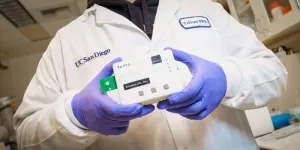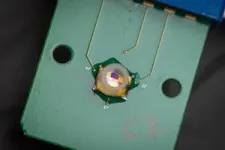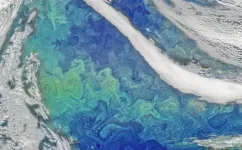(Press-News.org) An international team of researchers has developed a handheld, non-invasive device that can detect biomarkers for Alzheimer’s and Parkinson’s Diseases. The biosensor can also transmit the results wirelessly to a laptop or smartphone.
The team tested the device on in vitro samples from patients and showed that it is as accurate as the state of the art. Ultimately, researchers plan to test saliva and urine samples with the biosensor. The device could be modified to detect biomarkers for other conditions as well.
Researchers present their findings in the Nov. 13, 2023 issue of the Proceedings of the National Academy of Sciences.
The device relies on electrical rather than chemical detection, which researchers say is easier to implement and more accurate.
“This portable diagnostic system would allow testing at-home and at point of care, like clinics and nursing homes, for neurodegenerative diseases globally,” said Ratnesh Lal, a bioengineering, mechanical engineering and materials science professor at the UC San Diego Jacobs School of Engineering and one of the paper’s corresponding authors.
By the year 2060, about 14 million Americans will suffer from Alzheimer’s Disease. Other neurodegenerative diseases, such as Parkinson’s, are also on the rise. Current state of the art testing methods for Alzherimer’s and Parkinson’s require a spinal tap and imaging tests, including an MRI. As a result, early detection of the disease is difficult, as patients balk at the invasive procedures. Testing is also difficult for patients who are already exhibiting symptoms and have difficulty moving as well as those who have no early access to local hospitals or medical facilities.
One of the prevailing hypotheses in the field, which Lal has focused on, is that Alzheimer’s Disease is caused by soluble amyloid peptides that come together in larger molecules, which in turn form ion channels in the brain.
Lal wanted to develop a test that would be able to detect amyloid beta and tau peptides – biomarkers for Alzheimer’s – and alpha synuclein proteins – biomarker for Parkinson’s – non invasively, specifically from saliva and urine. He wanted to rely on electrical rather than chemical detection, as he believes it is easier to implement and more accurate. He also wanted to build a device that could wirelessly transmit the test results to the patient’s family and physicians. The device is the result of his three decades of expertise, as well as his collaboration with researchers globally, including those co-authors in this work from Texas and China.
“I am trying to improve quality of life and save lives,” he said.
To realize Lal’s vision, he and colleagues adapted a device they developed during the COVID pandemic to detect the spike and nucleoprotein proteins in the live SARS-CoV-2 virus, which they described in PNAS in 2022. That breakthrough had been made possible by chip miniaturization and by large-scale automation of biosensor manufacturing.
How the device is made and how it works
The device described in the 2023 PNAS study, consists of a chip with a high sensitivity transistor, commonly known as a field effect transistor (FET). In this case, each transistor is made of a graphene layer that is a single atom thick (GFET, with the G standing for graphene) and three electrodes–source and drain electrodes, connected to the positive and negative poles of a battery, to flow electric current, and a gate electrode to control the amount of current flow.
Connected to the gate electrode is a single DNA strand, which serves as a probe that specifically binds to either amyloid beta, tau or synuclein proteins. The binding of these amyloids with their specific DNA strand probe, called an aptamer, changes the amount of current flow between the source and drain electrode. The change in this current or voltage is the signal used to detect the specific biomarkers, like amyloids or COVID 19 proteins.
The research team tested the device with brain-derived amyloid proteins from Alzheimer’s and Parkinson’s deceased patients. The experiments showed that the biosensors were able to detect the specific biomarkers for both conditions with great accuracy, on par with existing state of the art methods. The device also works at extremely low concentrations, meaning that it needs small quantities for samples–down to just a few microliters.
In addition, the tests showed that the device performed well even when the samples analyzed contained other proteins. Tau proteins were more difficult to detect. But because the device looks at three different biomarkers, it can combine results from all three to arrive at a reliable overall result.
The technology has been licensed from UC San Diego to a biotechnology startup Ampera Life. Lal is the company’s chairman but does not receive financial support for his research from the company.
Next steps include testing blood plasma and cerebro-spinal fluid with the device, then finally saliva and urine samples. The tests would take place in hospital settings and nursing homes. If those tests go well, Ampera Life plans to apply for FDA approval for the device, hopefully in the next five or six months. The ultimate goal is to have the device on the market in a year.
Funding for the research came from the National Institutes of Health, the University of California San Diego and the Chinese Academy of Sciences. In addition, researchers used facilities that are a part of the NSF-funded UC San Diego Materials Research Science and Engineering Center.
In pursuit of degenerative brain disease diagnosis: dementia biomarkers detected by DNA aptamer-attached portable graphene biosensor
University of California San Diego: Tyler A. Bodily, Anirudh Ramanathan, Abhijith Karkisaval, Armando Rami, Prachi Heda. M. Leite, Ratnesh Lal
Shanghai Institute of Microsystem Information Technology Shahong Wei, Yi WAng, Tie Li, Jianlong Zhao
University of the Chinese Academy of Sciences Shahong Wei
University of Texas Medical Branch, Galveston, Texas Nemil Bhatt, Cynthia Jerez, Md Anzarul Haque
University of Illinois Urbana-Champaign Sanjeev Kumar
END
This wireless, handheld, non-invasive device detects Alzheimer’s and Parkinson’s biomarkers
Next steps include testing saliva and urine samples with the biosensor
2023-11-13
ELSE PRESS RELEASES FROM THIS DATE:
Evolution of taste: Sharks were already able to perceive bitter substances
2023-11-13
A research team from the University of Cologne, in collaboration with colleagues from the Leibniz Institute for Food Systems Biology in Freising, has discovered a receptor for bitter taste in twelve different cartilaginous fish (sharks and rays). The receptor belongs to the so-called taste receptors type 2 (T2R), which also make humans perceive bitter and potentially toxic foods. Until now, it was assumed that such receptors only occur in bony vertebrates. The work was published under the title ‘A singular shark bitter taste receptor provides insights into the evolution of bitter taste perception’ ...
North Atlantic’s marine productivity may not be declining, according to new study of older ice cores
2023-11-13
To paraphrase Mark Twain, reports of declining phytoplankton in the North Atlantic may have been greatly exaggerated. A prominent 2019 study used ice cores in Antarctica to suggest that marine productivity in the North Atlantic had declined by 10% during the industrial era, with worrying implications that the trend might continue.
But new research led by the University of Washington shows that marine phytoplankton — on which larger organisms throughout the marine ecosystem depend — may be more stable than believed in the North Atlantic. The team’s analysis of an ice core going ...
New study shows perception of aging is linked to level of physical activity in arthritis patients
2023-11-13
People with arthritis who report more negative feelings about how they are aging tend to get less physical activity and perceive themselves as less healthy, according to a new study by researchers at Hospital for Special Surgery (HSS) and Weill Cornell Medicine. However, self-perception of good health explained the effect of negative thinking – providing an opportunity for clinicians to focus on a patient’s outlook on aging as well as their overall health.
“Physical activity is essential for older adults with arthritis, as it can help to reduce pain and stiffness, improve ...
Researchers take new AI approach to analyze tumors
2023-11-13
Researchers at Karolinska Institutet and SciLifeLab in Sweden have combined artificial intelligence (AI) techniques used in satellite imaging and community ecology to interpret large amounts of data from tumour tissue. The method, presented in the journal Nature Communications, could contribute to more personalised treatment of cancer patients.
While recent advances in tumour imaging provide a great insight into the microscopic world of tumours, the challenge is to interpret the huge amount of data generated. With hundreds of molecules being measured simultaneously in tens or hundreds of thousands of cells, it has become difficult for researchers to know what molecules and cells ...
Diverse forests hold huge carbon-storage potential, as long as we cut emissions, study shows
2023-11-13
Media kit
New research suggests that a realistic estimate of additional global forest carbon-storage potential is approximately 226 gigatonnes of carbon—enough to make a meaningful contribution to slowing climate change.
The study, published today in the journal Nature, highlights the critical importance of forest conservation, restoration and sustainable management in moving toward international climate and biodiversity targets. It involved hundreds of scientists around the world, who stress that this potential can be achieved by incentivizing community-driven efforts to promote biodiversity.
Forest ...
New discovery on how green algae count cell divisions illuminates key step needed for the evolution of multicellular life
2023-11-13
ST. LOUIS, MO, November 13, 2023 — An international research team led by James Umen, PhD, member, Donald Danforth Plant Science Center has made an unexpected discovery of a biased counting mechanism used by the single-celled green alga Chlamydomonas to control cell division. Chlamydomonas cells can grow very large and then divide multiple times in succession. The team found that the number of divisions a mother cell undertakes to restore its daughters to the correct starting size deviates from the mathematical optimum that was assumed to dictate ...
French and U.S. science agencies take first step to collaborate on electron-ion collider (EIC)
2023-11-13
PARIS, NOV. 13—Representatives from the U.S. Department of Energy’s (DOE) Office of Science and the French Alternative Energies and Atomic Energy Commission (CEA) have signed a “Statement of Interest” to launch what both agencies hope will be a significant collaboration on the Electron-Ion Collider (EIC). The EIC, being built in the U.S. at DOE’s Brookhaven National Laboratory in partnership with DOE’s Thomas Jefferson National Accelerator Facility (Jefferson Lab), will be a unique facility for exploring the building blocks of matter and the strongest force in nature. The agreement continues a long history of cooperation in scientific ...
Study finds people with inflammatory arthritis face significant psychological challenges in maintaining employment
2023-11-13
SAN DIEGO, CA, NOVEMBER 13, 2023 — Research from Hospital for Special Surgery (HSS) reveals a significant psychological impact related to inflammatory arthritis patients’ efforts to maintain employment while coping with the challenges of their illness. The study, titled “The Psychological Experience of Work for People with Inflammatory Arthritis (IA),” was presented at the American College of Rheumatology (ACR) Convergence 2023 on November 13 in San Diego.
“A large body of research indicates that people with inflammatory arthritis are at increased risk for work disability, which can profoundly affect their lives. ...
How marine bristle worms use a special protein to distinguish between sunlight and moonlight
2023-11-13
In a recent publication in Nature Communications, a joint research team of Johannes Gutenberg University Mainz (JGU), the University of Cologne, and the University of Oldenburg has presented their findings on the functioning of an atypical cryptochrome protein (Cry). These proteins are found in a variety of organisms, and they are often involved in light-controlled biological processes. The marine bristle worm Platynereis dumerilii, for example, employs a special Cry protein designated L-Cry to distinguish between sunlight and moonlight as well as between different moon phases. This is essential for the worms ...
Artificial intelligence: Unexpected results
2023-11-13
Artificial intelligence (AI) is on the rise. Until now, AI applications generally have “black box” character: How AI arrives at its results remains hidden. Prof. Dr. Jürgen Bajorath, a cheminformatics scientist at the University of Bonn, and his team have developed a method that reveals how certain AI applications work in pharmaceutical research. The results are unexpected: the AI programs largely remembered known data and hardly learned specific chemical interactions when predicting drug potency. The results have now been published in Nature Machine Intelligence.
Which drug molecule is most effective? Researchers are feverishly ...
LAST 30 PRESS RELEASES:
Ribosomal engineering creates “super-probiotic” bacteria
This self-powered eye tracker harnesses energy from blinking and is as comfortable as everyday glasses
Adverse prenatal exposures linked to higher rates of mental health issues, brain changes in adolescents
Restoring mitochondria shows promise for treating chronic nerve pain
Nature study identifies a molecular switch that controls transitions between single-celled and multicellular forms
USU chemists' CRISPR discovery could lead to single diagnostic test for COVID, flu, RSV
Early hominins from Morocco reveal an African lineage near the root of Homo sapiens
Small chimps, big risks: What chimps show us about our own behavior
We finally know how the most common types of planets are created
Thirty-year risk of cardiovascular disease among healthy women according to clinical thresholds of lipoprotein(a)
Yoga for opioid withdrawal and autonomic regulation
Gene therapy ‘switch’ may offer non-addictive pain relief
Study shows your genes determine how fast your DNA mutates with age
Common brain parasite can infect your immune cells. Here's why that's probably OK
International experts connect infections and aging through cellular senescence
An AI–DFT integrated framework accelerates materials discovery and design
Twist to reshape, shift to transform: Bilayer structure enables multifunctional imaging
CUNY Graduate Center and its academic partners awarded more than $1M by Google.org to advance statewide AI education through the Empire AI consortium
Mount Sinai Health system receives $8.5 million NIH grant renewal to advance research on long-term outcomes in children with congenital heart disease
Researchers develop treatment for advanced prostate cancer that could eliminate severe side effects
Keck Medicine of USC names Christian Pass chief financial officer
Inflatable fabric robotic arm picks apples
MD Anderson and SOPHiA GENETICS announce strategic collaboration to accelerate AI-driven precision oncology
Oil residues can travel over 5,000 miles on ocean debris, study finds
Korea University researchers discover that cholesterol-lowering drug can overcome chemotherapy resistance in triple-negative breast cancer
Ushikuvirus: A newly discovered giant virus may offer clues to the origin of life
Boosting the cell’s own cleanup
Movement matters: Light activity led to better survival in diabetes, heart, kidney disease
Method developed to identify best treatment combinations for glioblastoma based on unique cellular targets
Self-guided behavioral app helps children with epilepsy sleep earlier
[Press-News.org] This wireless, handheld, non-invasive device detects Alzheimer’s and Parkinson’s biomarkersNext steps include testing saliva and urine samples with the biosensor






